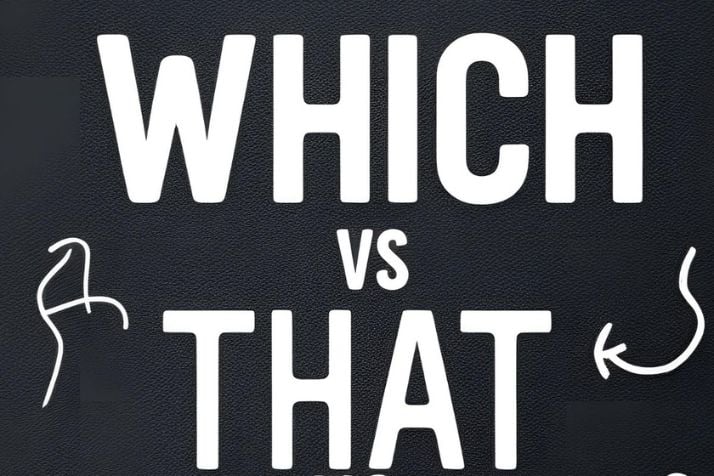Wait… did your email just confuse the entire office?
Email Text: “The emails which I sent yesterday, that had important client information are probably confusing everyone in the office right now.”
And now people are scratching their heads, rereading it three times, and still not sure what you meant.
Were you trying to say: “those emails with client info are confusing everyone,” but it ended up sounding like “some mystery emails maybe had info, maybe didn’t, who knows anymore?”
If yes, don’t worry—grammar mistakes happen all the time. These two words can quietly mess with sentence meaning.
And that’s exactly what we’re covering in this blog.
We’ll show you the clear difference between “which” and “that,” when to use which and that, how commas change everything, and how AI tools can fix the grammar mistakes in seconds.
Let’s get started.
The Basic Rule: Restrictive vs Nonrestrictive Clauses
There are two kinds of extra information you can add to a sentence — one you can’t remove, and one you totally can.
- The kind you can’t take out is called a restrictive clause. They’re like your name or address – without them, people wouldn’t know exactly what you’re talking about.
- These clauses don’t use commas, and they almost always use “that.”
- The kind you can remove is a nonrestrictive clause. This is the extra information that’s nice to know but not totally necessary.
- They’re always wrapped in commas (like this!), and they use “which.”
For example,
- The book that has a red cover is mine. (This tells you exactly WHICH book I’m claiming – the red one, not the blue one or any other book.)
- The book, which has a red cover, is mine. (This tells you I own a specific book, and oh by the way, it happens to be red. The color is just extra information.)
In the first sentence, if we removed “that has a red cover,” we’d just have “The book is mine” – but which book? We wouldn’t know! That’s why it’s restrictive.
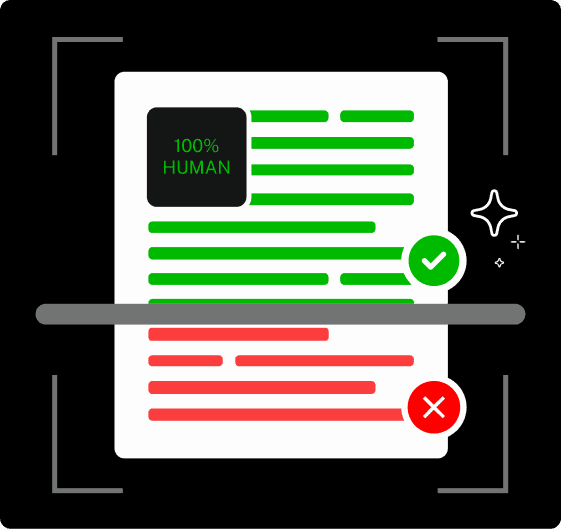

Never Worry About AI Detecting Your Texts Again. Undetectable AI Can Help You:
- Make your AI assisted writing appear human-like.
- Bypass all major AI detection tools with just one click.
- Use AI safely and confidently in school and work.
In the second sentence, if we removed “which has a red cover,” we’d still know exactly which book I’m talking about. The red cover detail is just a bonus fact.

Source = Blog.Inkforall
Pro Tip: Use a simple “drop test” if you want to confirm when to use which vs that. Remove the clause from your sentence. If the sentence still means basically the same thing, use “which” with commas.
If dropping it changes what you’re talking about completely, use “that” without commas.
When to Use “That”
Now let’s talk about “that.”
You only use “that” when the information is really important — like, don’t-leave-it-out-or-the-whole-meaning-changes kind of important.
We call this a restrictive clause. And it helps the reader know exactly what you’re talking about.
For example,
- Dogs that bark often annoy the neighbors.
That little part — “that bark” — is telling us which dogs we’re talking about. Not all dogs. Just the ones that bark.
Take that part out and now it sounds like all dogs annoy the neighbors.
(Which… maybe true in some places, but that’s not the point.)
So here’s the rule:
Use “that” when the extra words are needed to define what you’re saying, and don’t put a comma before it.
Why?
Because commas are like soft pauses. If you pause before something essential, it makes it sound optional. And that can mess things up—badly.
When to Use “Which”
Use “which” when you’re adding extra details — like the kind of info that’s nice to know, but not needed to understand the main point. This is called a nonrestrictive clause.
It doesn’t lock anything in. It just adds color, flavor, or background.
For example,
- The car, which I bought yesterday, is electric.
Let’s break that down.
The main idea = The car is electric.
The part that says “which I bought yesterday” — that’s just bonus info. You could leave it out, and the sentence would still make sense.
Here’s the grammar rule:
You must put a comma before “which.” It’s like saying to the reader: “Hey, this is a side note — not the main message.”
The bottom line….
“Which” → describes.
“That” → defines.
Read this blog to practice using which vs that clauses >> Which vs. That: How to Choose the Correct one Every Time
How Punctuation Changes Meaning
We already said that commas change meaning. Now let’s really see it in action—especially when it comes to which vs that.
Look at these two sentences:
- My brothers who live in New York are coming to visit.
- My brothers, who live in New York, are coming to visit.
They look almost the same, right? But they mean very different things.
The first one (no commas) means → Only the brothers who live in New York are coming. Maybe you have other brothers in other places, and they’re not coming.
The second one (with commas) means → All your brothers live in New York. And they’re all coming to visit. All from just a pair of commas.
Let’s try one more:
- Let’s eat, Grandma!
= You’re inviting Grandma to eat.
- Let’s eat Grandma!
= …Well, now you’re eating Grandma.
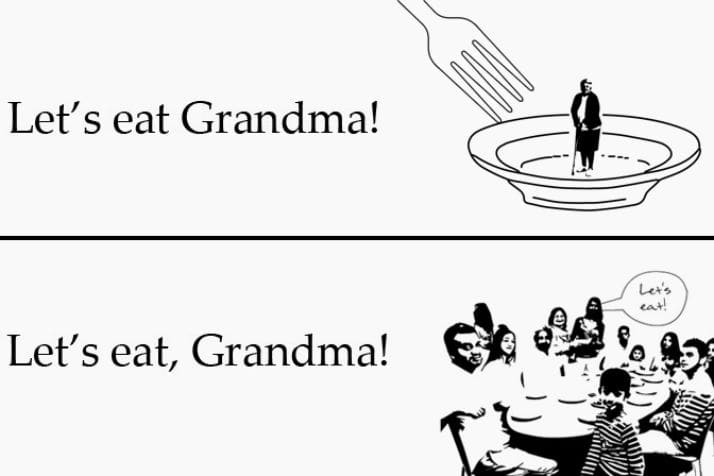
Source = Digital Synopsis
This seems like a small grammar mistake, but it creates confusion. And sometimes, you might have to pay millions of dollars in case settlement.
That’s exactly what happened in Maine, when a group of delivery drivers sued their company over unpaid overtime.
The law listed jobs that didn’t get overtime pay:
“Canning, processing, preserving, freezing, drying, marketing, storing, packing for shipment or distribution of perishable foods.”
But there was no comma before “or distribution.” The drivers argued that “packing for shipment or distribution” was one task, and since they only did distribution—not packing—they should get overtime.
The court agreed, and the company ended up paying $5 million to settle the case.
Common Mistakes and Myths
Alright, let’s talk about the top five myths and mistakes to avoid when it comes to which vs. that.
Myth #1: “It’s just about style.”
Nope. The choice between “which” and “that” changes the entire meaning of a sentence.
For example,
- Cars that have sunroofs are more expensive.
→ Only some cars have sunroofs. Those ones cost more. - Cars, which have sunroofs, are more expensive.
→ You’re saying all cars have sunroofs. (Not likely!)
See the difference? That = specific. Which = general extra info.
Myth #2: “You should always replace ‘which’ with ‘that.’”
This myth leads to what’s jokingly called “which hunting” — over-correcting every “which” into a “that.” But each word serves a different grammatical role.
Bad correction:
- My phone, that is charging, is on the table.
→ “That” can’t follow a comma. This is wrong.
Correct:
- My phone, which is charging, is on the table.
→ Now it works — just adding a detail.
Myth #3: “Everyone uses the same rule.”
Not true across the world. In American English, “that” is standard for restrictive clauses:
- The shirt that fits best is blue. (No comma, uses “that”)
But in British English, it’s common to see:
- The shirt which fits best is blue. (Still no comma, but “which” is okay there)
So in the U.S., “that” is preferred for essential info (restrictive clauses), while in the U.K., “which” is often used in the same way—even without a comma.
To learn more about the differences between British and American English, read this blog >> Comparison of American and British English.
Myth #4: “Who / which / that — it’s all the same.”
Nope. These aren’t interchangeable.
Quick guide:
- Use “who” for people.
→ The teacher who helped me was kind. - Use “that” or “which” for things.
→ The dog that barked ran away.
→ The story, which I heard yesterday, is true. - Use “which” with commas when adding nonessential details — that’s your nonrestrictive clause.
Myth #5: “You can drop ‘that’ anytime—it’s just extra.”
Not always. Dropping “that” too soon can cause confusion or awkwardness.
Compare these:
- Correct: She said that she would call. (Clear, flows naturally)
- Wrong: She said she would call. (Still okay, but can feel rushed or vague depending on context)
But now look at this:
- Correct: The news that shocked everyone was true.
- Wrong: The news shocked everyone was true. (Wait—what? That’s a mess.)
Sometimes “that” is needed to connect ideas clearly. Skipping it may sound casual, but it can trip up your reader — especially in complex sentences.
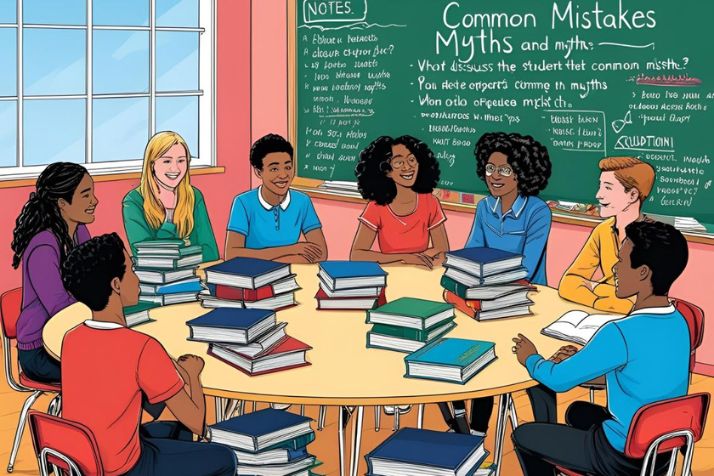
Style Guide Recommendations
A style guide is a rulebook for writing. It helps make sure everything you write looks, sounds, and feels the same way—whether it’s grammar, punctuation, how to use words, or how to format things like headings or citations.
When it comes to using “which” and “that,” most writing rulebooks follow clear rules.
1 – The Chicago Manual of Style
Chicago is the go-to for many publishers and academic writers, especially in book publishing. It takes a more formal tone. In this style guide:
- “That” should be used for restrictive clauses (no comma).
- Example: The book that is on the shelf is mine.
- “Which” should be used for nonrestrictive clauses (with a comma).
- Example: The book, which is on the shelf, is mine.
2 – APA and MLA
The APA (American Psychological Association) and MLA (Modern Language Association) styles are widely used in academic and research writing.
And they follow Chicago’s grammar rules for which vs. that
- Use “that” for restrictive, defining clauses.
- Use “which” (with a comma) for nonessential details.
3 – IEEE Style
IEEE (Institute of Electrical and Electronics Engineers) emphasizes clarity over strict formality.
It generally prefers “that” for restrictive clauses — just like the others — but it allows for “which” if it doesn’t create confusion.
Their goal is clear communication, especially in technical fields where precision is key.
Know Your Style Guide
Not all industries follow the same rules. Whether you’re writing for:
- A book publisher → likely using Chicago
- A university paper → probably APA or MLA
- A technical document → likely IEEE
- A corporate team or brand → they may have their own internal style guide
The key to professional writing is knowing which style guide applies, how it treats which vs. that, and following those grammar rules consistently.
Examples in Real Context
When you’re writing, whether it’s for marketing, academics, or even in legal contracts, knowing the difference between “that” and “which” matters a lot.
Here’s how it shows up in the real world:
1 – Marketing Copy
In marketing communication, clarity sells. You need to clearly separate essential product details from optional ones.
Using “that” and “which” correctly helps avoid customer confusion—crucial in conversion-focused copywriting.
Example:
- The phone that comes with a 2-year warranty is a great deal.
→ Only the phones with the warranty are the deal.
- The phone, which comes with a 2-year warranty, is a great deal.
→ All phones are deals — the warranty is just a value-add.
2 – Academic Writing
In academic writing, precision builds credibility. Misusing “that” or “which” can shift the meaning of your argument or hypothesis—a risk you don’t want in a peer-reviewed paper.
Example:
- The research that we conducted shows promising results.
→ Refers to a specific study that’s central to the paper.
- The research, which we conducted last year, shows promising results.
→ Adds background context, not central to the argument.
3 – Legal Contracts
In legal writing, precision is a non-negotiable. The wrong clause structure can create legal loopholes, misinterpretation, or even lead to lawsuits.
Example of Ambiguity:
- The property that is located on Main Street is available for sale.
→ Only the Main Street property is up for sale.
- The property, which is located on Main Street, is available for sale.
→ Could imply all properties are for sale, and this one just happens to be on Main Street.
4 – News Headlines
In journalistic writing, especially headlines, readability and accuracy are critical. One misplaced clause can mislead readers or change the narrative entirely.
Example:
- The mayor, who was caught in a scandal, resigns today.
→ The mayor is resigning; the scandal is just additional info. - The mayor that was caught in a scandal resigns today.
→ Only the mayor involved in the scandal is resigning.
How Undetectable AI Can Help
One grammar mistake in your writing can undermine your clarity. Not only does this confuse readers—it can cost you credibility, grades, conversions, or even legal accuracy.
Here’s how you can fix that and which mistake using Undetectable AI tools.
1 – Paraphrasing tool
Struggling to figure out whether your clause is restrictive or nonrestrictive? Or wondering if a comma is subtly changing your meaning?
Paraphrasing tool rewrites your sentence with the correct structure.
How It Works:
- Paste your sentence (or upload your document).
- Click ‘Paraphrase’ to see your content rephrased for clarity and grammatical accuracy.
- Check detection: See if your sentence sounds human-written.
- Copy, download, or humanize the result further.
For example,
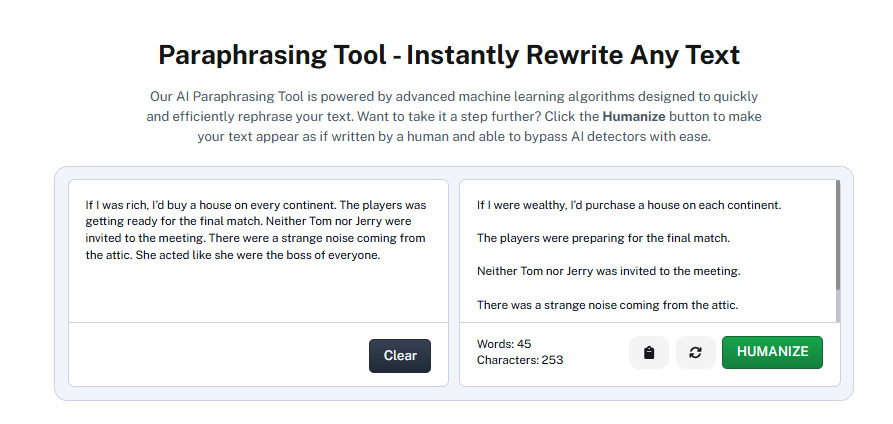
2 – Undetectable AI Chat
Have a grammar doubt? Want to double-check whether “that” or “which” makes your point clearer?
The Undetectable AI’s AI Chatbot can help you understand in seconds.
How to Use It:
- Ask a Question — e.g., “Should I use ‘that’ or ‘which’ in this sentence?”
- Get a Clear Answer — instantly explained with examples.
- Repeat as needed — for any writing, anytime.
For example,
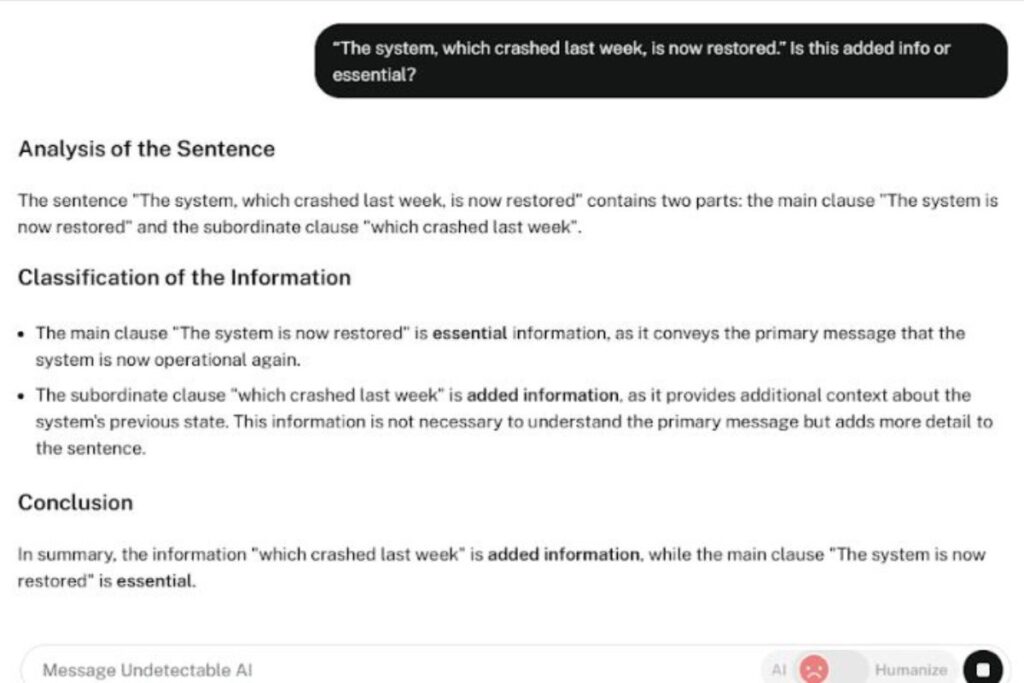
Scroll down and see what our AI Detector and Humanizer can do!
FAQs: That vs Which
Can I use “which” without a comma?
Only if following British conventions; avoid in US writing.
What if I leave out “that”?
Leaving out “that” can make your sentence smoother, but it also opens the door to ambiguity—especially in restrictive clauses where the information is essential.
Does it really matter which one I use?
Yes, it absolutely matters which one you use—“that” or “which”—because the choice affects clarity, tone, and even how your writing is received by different audiences or in different regions.
Final Thoughts
So—does it really matter whether you use “that” or “which”? Actually, yes.
It’s not about nitpicking grammar rules or impressing the grammar police. It’s about intention. Clarity. Precision.
The ability to guide your reader without confusion or noise. That’s powerful.
And it’s something every writer—whether you’re drafting an email or a novel—deserves to feel confident doing.
But you don’t need to memorize every rule to be a good writer. You just need to care about being understood.
Revisit the distinctions. Use the quick-reference tip sheet. Try the exercises. Because the more you practice, the more natural it feels.
And over time, you’ll find yourself writing not just with clarity, confidence, and intention.
Isn’t that the whole point?
Want a second pair of eyes—or just a quick grammar check?
Try Undetectable’s AI Chat to clarify your writing, fix tricky sentences, and boost your confidence in seconds.
